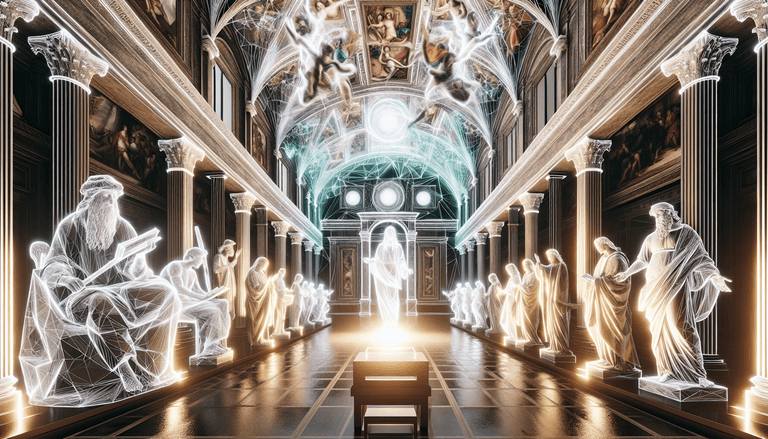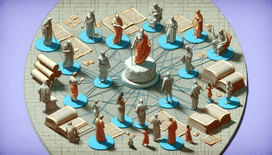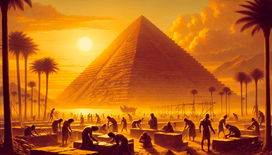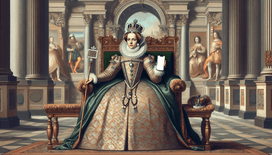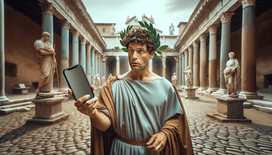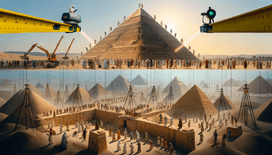Leonardo da Vinci: the man whose to-do list was longer than the queue for a new smartphone release. Often mistaken for a man of many talents, he was actually a man of many obsessions, ranging from painting masterpieces and designing flying machines to doodling mustaches on his Mona Lisa sketches. Yes, folks, da Vinci was a true Renaissance multitasker, arguably straddling the line between creative genius and historic hoarder of hobbies.
But what if I told you that our dear Leo had access to virtual reality (VR) whilst working on the Sistine Chapel? Buckle up, dear readers, as we dive into a world where time, technology, and tingling creativity converge.
The Original Conundrum
A small clarification for those who have been time travelling to the wrong art museums: technically, it was Michelangelo, another member of the Teenage Mutant Ninja Turtles cast, who painted the Sistine Chapel ceiling. However, Leonardo played a significant role in the Renaissance art scene, and in our surreal scenario, he is roped into this heavenly art project.
The Sistine Chapel project was as complex as a Rubik's Cube solved by an over-caffeinated octopus. The fresco required an artist to paint on scaffoldings while stretching, craning, and angling like a yogi in pursuit of enlightenment. Naturally, this led to a boom in chiropractor visits among Renaissance painters.
Enter Virtual Reality
And so, in our alternate universe, we bestow Leonardo with a VR headset, allowing him to visualise and interact with a three-dimensional model of the Chapel. Suddenly, no more nail-biting decisions on where to pontificate cherubs or precariously precarious positioning of the Patriarchs.
Through VR, Leonardo could have taken an immersive tour around his mock-up of the Chapel ceiling, like a celestial landlord inspecting his heavenly property. This new perspective would not only offer Leonardo a chance to experiment with concepts in a virtual realm, but also potentially reserve his reclining talents for indulging in Renaissance pizza rather than perpetual fresco yoga.
Drafting Dreams in a Digital Da Vinci Delight
With VR, Leonardo could pause when he pleased and scrutinise intricate details with the avid concentration usually reserved for spotting hidden meanings in Shakespearean sonnets. Left hand holding the virtual brush, right hand guiding the ethereal vision, and a cheeky grin plastered across his face, he would deftly manoeuvre around his artwork.
Imagine him updating divine designs via a virtual stylus and a flick of his wrist, muttering critiques like, "David really ought to hit the Renaissance gym," or "My, such cherubic cheeks, bless the Creator." The rest of the Brotherhood of Renaissance Artists (BORA) might have marvelled at his newfound freedom, a creative maverick painting in mid-air as if possessed by celestial muses.
Erasing Errors and Editing Eternity
Gone would be the days of chisel-oopsies, accidents bemoaned in many an artist's diary. With VR, Leonardo could undo a disagreeably draped drapery with the ease of pressing ‘control-Z.’ Such divine powers over his designs would save the Fresco Fab from climbing down scaffolding to engage in impromptu existentialism every time a cherub’s hair proved too curly.
Of course, not all blunders would cease to exist. Imagine Leonardo accidentally enabling voice navigation settings, only to be greeted by a chirpy AI avatar suggesting: “You seem to be painting a lot of angels. Would you like to see other celestial configurations?” Cue the heavenly side-eye from the angels above and below, and yes, in VR, sideways too.
A Renaissance Revolution or a Reimagined Chaos?
As the speculative paint dries on our hypothetical Sistine VR Exploration, one can't help but ponder: Would such novel technology hasten the completion of one of the world’s most beloved works or unearth a canvas of chaos? Perhaps the true Renaissance da Vinci required the wooden scaffold, the exhaustion, the colleague camaraderie, and even the accidental paint drip.
The beauty of history, after all, lies in its imperfections. Yet, it’s tantalising to imagine a VR-enhanced da Vinci, embedding cathartic, unexpected pleasures into one of history's greatest treasures. And no doubt, given his obsessive detail, he might still be there today, tweaking every ethereal stroke, sipping espresso from his VR headset, all the while awaiting that elusive sense of perfection.
So, dear readers, the next time you don your own VR headset and draw mind-bending masterpieces in digital realms, spare a thought for Leonardo, a man ahead of his time, whose Renaissance spirit lives on, pixelating possibility and breathing life into art through the lens of innovation.
